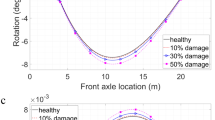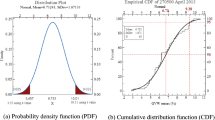Abstract
In a bridge design code, the design live loads should be based on actual traffic loads. In the past, the information about the actual truck loads on highway bridges was obtained from truck surveys, in which the trucks are stopped for measurement and weighed on ‘static’ weighing scales. During the past few decades, however, the information about truck loads is collected either by pavement weigh-in-motion or bridge weigh-in-motion (BWIM) systems. This paper provides details of three BWIM methods, which were calibrated with extensive testing on a slab-on-girder bridge in Winnipeg, Canada. The first two methods are based on the assumption that truck loads could be represented by an equivalent uniformly distributed load. The first method uses the asymmetry in the shape of the bending moment diagram to calculate the gross vehicle weight (GVW), while the second method compares the girder response at two instrumented transverse sections. The third method calculates GVW using strain signal area as proposed by Ojio and Yamada in 2002. The results show that the first method was inconsistent in its accuracy; the second method’s accuracy reduced with the length of the vehicle. The third method proved consistent and accurate to within 5 % for the test trucks provided that the vehicle speeds could be estimated accurately. Accurate calculations of the truck speeds were achieved by using the time delay in the peak responses of the straps that confine the externally restrained deck slab of the bridge.
















Similar content being viewed by others
References
Moses F (1979) Weigh-in-motion system using instrumented bridges. ASCE Trans Eng J 106:233–249
Quilligan M, Karoumi R, O’Brien EJ (2002) Development and testing of a 2-dimensional multi-vehicle Bridge-WIM algorithm. 3rd int.conf. on weigh-in-motion (ICWIM3)
Znidaric A, Kalin J, Lavric I (2002) Bridge weigh-in-motion measurements on short slab bridges without axle detectors. 3rd int.conf. on weigh-in-motion (ICWIM3)
Harman DJ (1984) A study of commercial vehicles and their multiple presence. OJTCRP Project No. 23141, U. of W. Ontario, Faculty of Eng. Science, London, ON, Canada
Scott, G. (1987) Weighing-in-motion technology—status CULWAY in Australia. Australian Research Board Seminar on Road Traffic data collection using weighing-in-motion, Melbourne, Australia
Heywood RJ (1991) Bridge applications of WIM data. Proc, of the AUSTROADS Bridges Conf., In: ed. Heywood RJ, (ed.), Austroads, Haymarket, Australia, p 139–150
Yamada K, Ojio T (2003) Bridge weigh-in-motion system using reaction force method. Proc. of the Int. Workshop on Structural Health Monitoring of Bridges/Colloquium on Bridge Vibration’03. Japan Society of Civil Engineers, pp 269–276
Bakht B, Mufti AA, Tadros G, Eden R, Mourant G (2006) Weighing-in-motion of truck axle weights by Japanese reaction force method. 3rd Int. Conf. on Bridge Maintenance, Safety and Management, Porto, Portugal, July 16–19, pp 981–982
Wall CJ, Christenson RE, McDonnell A, Jamalipour A (2009) A non-intrusive bridge weigh-in-motion system for a single span steel girder bridge using only strain measurements. Report no. CT-2251-03-09-5. Connecticut Dep. of Transportation
Leming Sarah K, Stalford Harold L (2003) Bridge weigh-in-motion system development using superposition of dynamic truck/static bridge interaction. American control conf., proc. of the 2003IEEE. p 815
Deesomsuk T, Pinkaew T (2010) Evaluation of effectiveness of vehicle weight estimations using bridge weigh-in-motion. IES J Part A Civil Struct Eng 3(2):96–110
Law S, Bu J, Zhu X, Chan S (2004) Vehicle axle loads identification using finite element method. Eng Struct 26(8):1143–1153
Rowley CW, OBrien EJ, Gonzalez A, Žnidarič A (2009) Experimental testing of a moving force identification bridge weigh-in-motion algorithm. Exp Mech 49(5):743–746
González A, Rowley C, OBrien EJ (2008) A general solution to the identification of moving vehicle forces on a bridge. Int J Numer Methods Eng 75(3):335–354
Ojio T, Yamada K (2002) Bridge weigh-in-motion systems using stringers of plate girder bridges. 3rd int.conf. on weigh-in-motion (ICWIM3)
Canadian Standards Association (2006)CAN/CSA-S6-06, Canadian highway bridge design code
Acknowledgments
The authors wish to acknowledge the contribution of the late Dr. Leslie Jaeger in formulating the two-station method.
Author information
Authors and Affiliations
Corresponding author
Rights and permissions
About this article
Cite this article
Helmi, K., Bakht, B. & Mufti, A. Accurate measurements of gross vehicle weight through bridge weigh-in-motion: a case study. J Civil Struct Health Monit 4, 195–208 (2014). https://doi.org/10.1007/s13349-014-0076-5
Received:
Revised:
Accepted:
Published:
Issue Date:
DOI: https://doi.org/10.1007/s13349-014-0076-5




